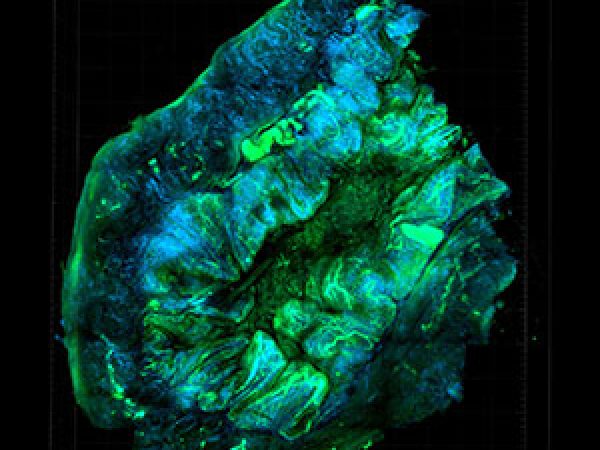Ductal Carcinoma In Situ: The Weight of the Word “Cancer”
What is cancer, exactly?
For the most part, experts agree. The National Cancer Institute defines cancer as “a disease in which some of the body’s cells grow uncontrollably and spread to other parts of the body.” The World Health Organization explains that cancer occurs when “abnormal cells grow uncontrollably, go beyond their usual boundaries to invade adjoining parts of the body, and/or spread to other organs.”
As conclusive as these definitions seem, they contain some room for interpretation. How do you classify a tumor that can become invasive but typically doesn’t? What do you call a group of cells that grows uncontrollably but often slowly?
Ductal carcinoma in situ (DCIS), a type of breast tumor, is classified as a “stage 0” breast cancer. The abnormal cells are confined within a single duct, and they often grow more slowly than most cancer cells. However, around 20 percent of DCIS cases eventually transform into invasive cancer or recur after the primary tumor is removed.
Does DCIS qualify as a cancer? Should it be treated using therapy regimens with potentially harmful side effects?
At the AACR Special Conference Rethinking DCIS: An Opportunity for Prevention? held in Philadelphia September 8-11, researchers candidly debated these topics and explained how something as simple as a label could have a lasting impact on treatment and the patient experience. For Breast Cancer Awareness Month, we bring you the experts’ take on these difficult topics and how finding common ground can bring the field closer to new treatment strategies.
Is DCIS Cancer?
While DCIS is currently classified as cancer, Jennifer Marti, MD, an assistant professor of surgery at Weill Cornell Medical College, believes there are several ways the description doesn’t quite fit.
Marti shared the definition of cancer found in Dorland’s Illustrated Medical Dictionary, which describes cancer as “a neoplastic disease, the natural course of which is fatal.” The natural course of DCIS, Marti argued, is rarely fatal; the large majority of patients who die of breast cancer following a DCIS diagnosis die from an invasive recurrence. These recurrences are not always genetically related to the original DCIS lesion, and many occur in the opposite breast.
Further, if DCIS directly leads to invasive cancer and death, increased detection and treatment of DCIS should lead to fewer cases of invasive cancer, Marti said. Between 1975 and 2016, the percentage of breast cancers diagnosed as DCIS rose from 3 percent to 25 percent as detection methods improved, but the invasive cancer rate increased rather than decreased.
“DCIS is a marker for breast cancer risk; it itself is not cancer,” Marti said. “Removing the speedometer does not change the speed of the car, so removing DCIS, irradiating it, or giving it pills will not change the risk of dying.”

Marti pushed for the reclassification of DCIS as a neoplasia—an abnormal patch of tissue that often indicates increased cancer risk. She showed that the risk of DCIS progression increases by 1 to 2 percent per year, similar to other breast neoplasias such as atypical ductal hyperplasia, atypical lobular hyperplasia, and lobular carcinoma in situ.
Marti argued that these other conditions aren’t treated as vigorously as DCIS, possibly due to their classification, and that renaming DCIS may therefore decrease overtreatment. She showed that around 20 percent of patients with DCIS receive a mastectomy (removal of a whole breast), around half of which are double mastectomies (removal of both breasts). Among patients who have only the tissue around a tumor removed (called a lumpectomy), 50 to 70 percent also undergo radiation, and around 40 percent receive hormone therapy.
“When you call it cancer, you’ll treat it as an aggressive cancer,” Marti concluded. “If you do a surgery like this, are you helping your patient live longer or live better?”
Steven Narod, MD, a senior scientist at the Women’s College Research Institute in Toronto, advocated to maintain DCIS’s current label. He began by refuting the basis for Marti’s stance—that DCIS is merely a risk factor.
While Marti emphasized that few cases of DCIS progress to invasive cancer, Narod argued that treating those few cases could prevent unnecessary relapses. In this way, DCIS acts more like an early-stage cancer than a risk factor.
Narod also challenged the notion that DCIS is only dangerous if it progresses or recurs as invasive disease. He showed that treating DCIS with a lumpectomy or mastectomy decreases the rate of recurrence within the same breast. However, these procedures do not decrease the mortality rate.

How is this possible if DCIS isn’t lethal in the absence of progression? Narod explained that researchers have observed circulating tumor cells, positive lymph nodes, and tiny bone micrometastases in DCIS patients with no evidence of tumor invasion.
“If a DCIS can metastasize, then that’s cancer,” Narod said. Although only 3 percent of DCIS tumors are estimated to have metastatic capabilities, Narod argued that, based on how other cancers are classified, the proportion of metastatic cases may not dictate what qualifies as cancer.
“If we require the capacity to metastasize in every member of a group of cancers to be a cancer, then 90 percent of cancers are not cancers,” he said. “Either we change the definition of cancer, or we come to the conclusion that DCIS is cancer.”
Moderator Laura Esserman, MD, MBA, FAACR, a professor of surgery at the University of California, San Francisco, led a discussion that brought Marti and Narod to a consensus: Some DCIS cases should be considered cancers and treated as such, and some should not. Audience members pointed out potential consequences of a sudden change in classification, including possible confusion and mistrust from prospective patients and a lack of available data in the National Cancer Institute’s Surveillance, Epidemiology, and End Results (SEER) database.
Therefore, the panelists agreed, any reclassification should be approached with caution. Differentiating “cancerous” DCIS cases from “noncancerous” ones may help, but the process will require stronger biomarkers of progression than the ones currently available. Nevertheless, Esserman is hopeful that such clarity is on the horizon.
“I am certain that there will be artificial intelligence capabilities to look at pathology slides to tell you what is in that more indolent biology,” she said.
Should DCIS Patients Receive Radiation?
Once the tumor is removed, many patients with DCIS have the option to undergo radiation therapy to further decrease their risk of cancer recurrence. However, some oncologists, such as Bruce Mann, MBBS, PhD, a professor of surgery at The Royal Melbourne Hospital in Australia, believe the benefits are rarely worth the risks.
Because radiation therapy for DCIS is directed at the chest, patients risk off-target damage to the heart and lungs, as well as the emergence of sarcomas in the chest cavity. Mann further showed that among breast cancer patients treated with surgery, those who received subsequent radiotherapy were more likely to report persistent pain after an average of 26 months.

MBBS, PhD
While many studies have demonstrated that radiation decreases the risk of a DCIS recurrence, Mann showed that it does not improve overall survival. This suggests that the side effects from radiotherapy may partially mitigate the DCIS-specific benefits.
Because the risk of recurrence is already low, Mann estimated that only 3 percent of DCIS cases would progress into life-threatening cancers, and that only one-third of those cases would be prevented by radiation. When compared with the rates at which radiation may cause additional cancers, Mann explained that radiation may cause one serious secondary cancer for every two life-threatening breast cancers prevented.
Mann pointed out that it is also important to ask patients about their preferences. In one study, 71 percent of surveyed women said they would accept a small increase in breast cancer risk in order to reduce morbidity. Another study showed that the majority of low-risk DCIS patients supported active surveillance, in which they are monitored for progression without intervention.
Nicolas Prionas, MD, PhD, a clinical assistant professor in the department of Radiation Oncology at the University of California, San Francisco, agreed that traditional whole-breast radiation poses significant risks to patients. However, newer radiation technologies may lower those risks, increasing the potential margin of benefit.
Prionas discussed ways to modulate the dose and area of application using image-guided, intensity-modulated radiotherapy, in order to minimize the healthy tissue caught in the crossfire. In this method, physicians use imaging to target the radiation directly to the tumor. They can adjust the size, shape, and intensity of the beam such that the cancer cells receive the highest dose, which can taper off in a gradient to the adjacent tissue.

MD, PhD
“Image guidance enables targeting of smaller treatment volumes, which lowers toxicity. We have better organ avoidance, and we can now do this in a convenient regimen with a small number of treatments,” Prionas explained.
With more precise targeting, patients could receive a fraction of the current standard dose of radiation, over five days instead of the typical 16. The FLORENCE clinical trial observed no difference in five-year same-breast recurrence rates between patients treated with the fractional dose and those treated with a standard dose. Those treated with the fractional dose also experienced fewer adverse side effects than those treated with a standard dose.
While these methods do not completely remove the risk of side effects, Prionas argued that active surveillance poses its own risks, which are often overlooked. One study showed that the rate of false-positive mammograms in the general population is 7 to 11 percent, which can translate to excess costs of around $4 billion per year. Especially for patients who have already experienced a cancer diagnosis, false-positive results can cause significant psychological stress, Prionas said.
During the panel discussion, Prionas and Mann agreed that safer, more targeted forms of radiation could certainly benefit a subset of DCIS patients, and that other patients may experience more harm than good. Maximizing the benefit again comes down to predicting which patients are likely to experience a recurrence.
“If you could identify a small group where the impact of radiation is enormous, then it’s likely that there will be a survival advantage, because they’re the ones who will have the invasive recurrences,” Mann said.
When asked how soon a robust set of biomarkers may be available for this purpose, Prionas referred to several gene array panels already in development, as well as liquid biopsy technologies that may help identify metastatic spread. Mann believes markers within the tumor may hold important clues, and that their patterns may become clearer with the development of better AI algorithms.
“We’ve heard a lot at this meeting about new markers,” Mann said. “I think it’s getting close.”



